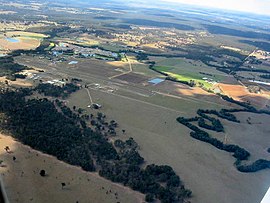Cessnock, New South Wales
|
Cessnock New South Wales |
|||||||
|---|---|---|---|---|---|---|---|

Cessnock, New South Wales
|
|||||||

Aerial photo of countryside around Cessnock
|
|||||||
| Coordinates | 32°50′3″S 151°21′19.8″E / 32.83417°S 151.355500°ECoordinates: 32°50′3″S 151°21′19.8″E / 32.83417°S 151.355500°E | ||||||
| Population | 22,596 (2015) | ||||||
| Postcode(s) | 2325 | ||||||
| Elevation | 80 m (262 ft) | ||||||
| Time zone | AEST (UTC+10) | ||||||
| • Summer (DST) | AEDT (UTC+11) | ||||||
| Location | |||||||
| LGA(s) | City of Cessnock | ||||||
| Region | Hunter | ||||||
| County | Northumberland | ||||||
| Parish | Cessnock | ||||||
| State electorate(s) | |||||||
| Federal Division(s) | Hunter | ||||||
|
|||||||
Cessnock is a city in the Hunter Region of New South Wales, Australia, about 52 km (32 mi) by road west of Newcastle. It is the administrative centre of the City of Cessnock LGA and was named after an 1826 grant of land called Cessnock Estate, which was owned by John Campbell. The local area was once known as "The Coalfields", and it is the gateway city to the vineyards of the Hunter Valley, which includes Pokolbin, Mount View, Lovedale, Broke, Rothbury, and Branxton. The estimated urban population of Cessnock was 22,596 at June 2015, having grown at an average annual rate, year-on-year, of 2.1 percent over the previous five years.
The transition to wine service centre from a once prosperous mining town has been a long and at times difficult process.
Cessnock lies between Australia’s earliest European settlements – Sydney, the Hawkesbury River and Newcastle. Lying on the land route between these important settlements it provided early European contact with indigenous people who have inhabited the Cessnock area for more than 3,000 years. The Wonnarua people were the major inhabitants at the time of European contact, which subsequently proved to be disastrous for the Wonnarua tribe. Many were killed or died as a result of European diseases. Others were forced onto neighbouring tribal territory and killed. The city of Cessnock abounds in indigenous place names and names with indigenous association which is indicative of this settlement and include Congewai, Kurri Kurri, Laguna, Nulkaba and Wollombi.
...
Wikipedia

